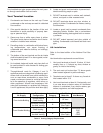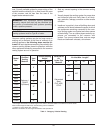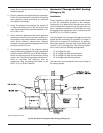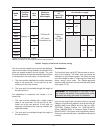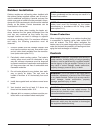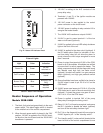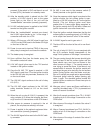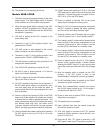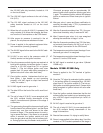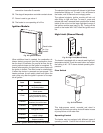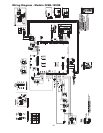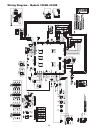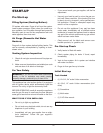
34
powered. If the switch is “ON” and there is no call
for heat (CFH), the heater is in standby mode.
18. After the standby switch is placed into the “ON”
position, a 24 VAC signal is sent to the green
power light on the front of the unit and the
“enable/disable” connection (normally jumpered).
19. 24 VAC switched power is applied to the 24VAC
terminal on the ignition module.
20. When the “enable/disable” contacts are closed,
the 24 VAC signal travels to pin 1 of the stage 1
connection and waits for a CFH.
21. When a CFH occurs, a 24 VAC signal is sent from
J-5 CFH on the CPW board to the amber CFH light
on the front of the unit.
22. Power is now sent to terminal TRIG of the pump
delay relay to energize it and close the contacts.
23. The heater pump is energized.
24. Upon sufficient flow from the heater pump, the
flow switch contact will close.
25. A 24 VAC signal is then sent to the “TH” terminal
located on the ignition module.
26. Once the 24 VAC “TH” signal is received, a 120
VAC signal is sent from F2 on the ignition module
to the 120 VAC pilot duty terminals, located at J-14
on the circuit board.
27. The 120 VAC signal continues to the coil of relay
K-3 (N.O.).
28. The 120 VAC signal continues to the 120 VAC
safety terminals located at J-13 on the circuit
board.
29. When the coil on relay K-3 (N.O.) is powered, the
relay contacts (K-3) close and energize the blow-
er(s) from the J-8 connections on the CPW board.
30. After proper air pressure is received in the air
plenum, the air pressure switch(s) will close.
31. Power is applied to the optional equipment inter-
lock connection (normally jumpered).
32. The 24 VAC signal is then sent to the 24 VAC safe-
ty connector.
33. 24 VAC is now sent to the pressure switch (P
Switch) terminal on the ignition module.
34. Once the pressure switch signal is received at the
ignition module, the hot surface igniter is ener-
gized by a 120 VAC signal from S-1 on the ignition
module. (The hot surface igniter must draw
greater than 3.2 amps while being energized or
the ignition module red LED will flash 4 times and
ignition lockout will occur after three tries).
35. Once the ignition module determines that the hot
surface igniter is operating properly, a 24 VAC sig-
nal is output from terminal “valve” of the module.
36. A 24 VAC signal is sent to gas valve 1.
37. The blue LED on the front of the unit is now illumi-
nated.
38. The coil of relay K-2 (N.O.) is now energized with
the (K-2) contacts closing downstream of the
stage 2 and upstream of the stage 3 connections.
39. The gas coming through the burners should ignite
from the heat of the hot surface igniter and the
flame should carry over from one burner to the
other burners of stage 1. The remote sensor is
now trying to sense the flame. If the flame is not
sensed within 4 seconds, the ignition module will
shut down the gas valve and retry the hot surface
igniter. During ignition retry the heater must per-
form a 15-second pre-purge and an approximately
30-second igniter warm-up before opening gas
valve 1 again. The standard ignition module will
attempt ignition a maximum of three times prior to
ignition lockout.
40. After gas valve 1 opens and flame rectification is
received, time delay relay 1 (TD-1) is powered and
starts a 5-second countdown.
41. After the 5 second countdown from TD-1, 24 VAC
is waiting at pin 3 of the stage 2 connection on the
CPW board.
42. After closure of the stage 2 contacts Gas valve 2
in energized.
43. After a 5 second countdown from TD-2, 24 VAC is
waiting at pin 5 of the stage 3 connection on the
CPW board.
44. After closure of the stage 3 contacts Gas valve 2
is energized.



